Chemistry (0620) Electrochemistry Revision Note
Hestia Laurent
This document explains electrochemistry for CAIE IGCSE Chemistry, focusing on electrolysis, electroplating, refining metals, and fuel cells. Electrolysis is defined as the decomposition of molten or aqueous ionic compounds using electricity, possible due to mobile ions. Key components include electrodes (anode = positive, cathode = negative), cations moving to the cathode, and anions to the anode. Reduction occurs at the cathode while oxidation happens at the anode, summarised by acronyms like OILRIG, REDCAT, ANOX, PANIC. Examples of electrolysis reactions are given for molten lead bromide, brine, dilute sulfuric acid, and copper sulfate with both graphite and copper electrodes. Electroplating is described as coating metals to prevent corrosion and improve appearance, while metal refining is explained with copper purification using impure copper anodes and pure cathode strips. The electrolysis of brine produces chlorine at the anode, hydrogen at the cathode, and sodium hydroxide solution. The section also introduces hydrogen-oxygen fuel cells, which combine hydrogen and oxygen to produce water and electricity, highlighting their advantages (clean, renewable) and disadvantages (large storage needs, high costs). With clear explanations and examples, this guide equips students with essential knowledge of electrochemical processes for exams.
See More Study and Revision Guide 3 months ago
Chemistry (0620) Subject directory
All resources in one place
Related Past Papers
Related Tutorials
Crash report

